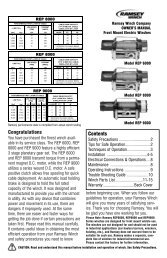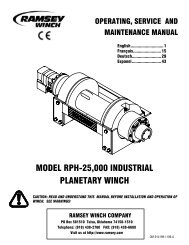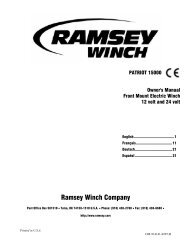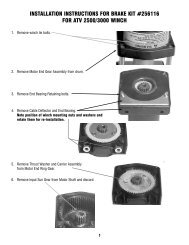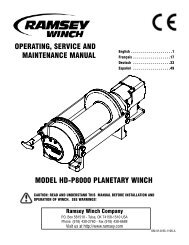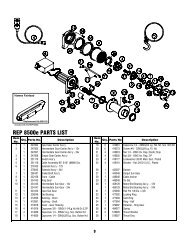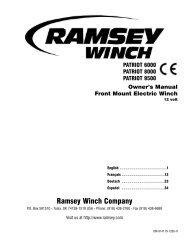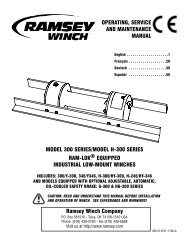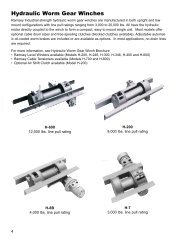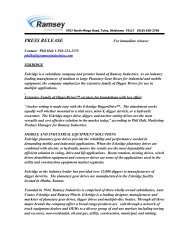Ramsey Winch Company
Ramsey Winch Company
Ramsey Winch Company
- No tags were found...
Create successful ePaper yourself
Turn your PDF publications into a flip-book with our unique Google optimized e-Paper software.
Operating InstructionsThe winch clutch allows rapid unspooling of the wire rope forhooking onto the load or anchor point. The clutch is operatedby the shifter knob located on the gear housing end of thewinch as follows:1. To disengage the clutch, move the clutch shifter knob tothe “OUT” position. Wire rope may now be freespooled offthe drum.2. To engage the clutch, move the clutch shifter knob into the“IN” position. The winch is now ready for pulling.Electrical Connections and OperationsSee the installation instructions for the Safety On/Off switch,Part No. 282062 (12V) or 282063 (24v) as applicable, suppliedwith the winch, to install the On/Off switch.For normal self-recovery work, your existing electrical systemis adequate. Your battery must be kept in good condition. Afully charged battery and proper connections are essential.Run the vehicle engine during winching operations to keepbattery charged.Route battery cables up to battery.CAUTION: BE SURE BATTERY CABLES ARE NOT DRAWN TAUT ACROSSANY SURFACES WHICH COULD POSSIBLY DAMAGE THEM.Connect red cable to positive (+) battery terminal. Connectblack ground cable to negative (-) terminal of battery (SeeFigure 1).Before operating the winch, turn ON the safety On/Off switchsupplied with the winch.The remote control switch is water proof. It has push buttonson either side. Make sure the motor has stopped fully beforereversing. To actuate winch simply plug remote control switchinto receptacle in cover of winch. Run winch forward andreverse to check directions. Snap appropriate “IN” and “OUT”disc into proper thumb cavity. Do not leave switch pluggedin when winch is not in use.MaintenanceAll moving parts in the winch are permanently lubricated withhigh temperature lithium grease at the time of assembly.Under normal conditions factory lubrication will suffice.Lubricate cable periodically using light penetrating oil. Inspectthe cable for broken strands and replace if necessary. If thecable becomes worn or damaged, it must be replaced.Corrosion on electrical connections will reduce performanceor may cause a short. Clean all connections especially in theremote control switch and receptacle. In salty environmentsuse a silicone sealer to protect from corrosion.To minimize corrosion of the internal motor components thatmay occur due to condensation, power the winch in or out9periodically. Energizing the motor will generate heat, which willhelp dissipate any moisture buildup in the motor. This shouldbe performed at periodic intervals (such as with each oilchange to your vehicle). Note: Refer to the TroubleshootingGuide if the motor has been submerged.Cable Installation1. Unwind the new cable by rolling it out along the ground toprevent kinking.2. Remove old cable and observe the manner in which it isattached to the cable drum flange.3. Before installing the new cable assembly, securely wrapthe end of the cable with plastic tape or similar tape to preventfraying.4. Position the cable drum so that the large 13/32” diameterhole in the motor end drum flange is approximately on thetop.5. Form a short bend (approximately 1/2” long) in the end ofthe cable. Insert the bend into the 13/32” hole in the drumflange and then carefully run the winch in the “reel in”direction approximately 3/4 revolution until the 1/4” diameterthreaded hole in the drum flange is on top.6. Secure the cable to the drum flange using cable anchorand capscrew shown in the parts drawing on page 11(Item nos. 20 and 30). Securely tighten the capscrew, butdo not over-tighten.7. Wind 5 wraps of cable onto the drum. Wind on the rest ofthe cable by pulling in a light load to keep the tension constant.Allow the cable to swivel by using a length of chainor a swivel block between the cable hook and the load.



